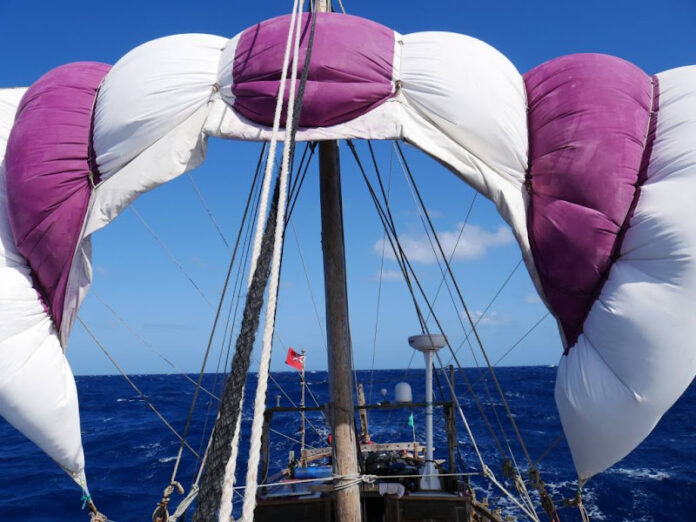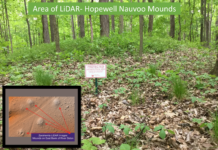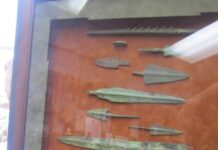Phoenicia Ship Expedition 2008
In March 2008 BBC South Today reported on the progress of the Phoenicia Ship Expedition. Interviews with Expedition Leader Philip Beale and Project Manager Alice Chutter. Learn more at www.phoenicia.org.uk.
Phoenicia sets sail from Syria
Phoenician Sailing Gibraltar
In 2009, The Phoenicia Ship Expedition has now demonstrated unequivocally that Lehi’s voyage could have left the Arabian Peninsula and sailed around Africa to the Americas rather than attempting to cross the earth’s largest ocean at its widest point, as proposed by Mesoamerican theorists.
In 2020 this same Phoenicia Ship Expedition has also demonstrated that Zedikiah’s son, Mulek escaped the Babylonians and could have left the area of Jerusalem on a Phoenician 600 BC style ship which sailed to the new world and continued near Florida and up the Mississippi (Sidon) River and landing in present day Montrose, Iowa across the river from Nauvoo, Illinois. This one replica 600 BC ship has proven two very important voyages testified about in the Book of Mormon, that were accomplished. This Phoenician Ship has sailed over 40,000 nautical miles in the past 10 years or so, and the Heartland Group now owns this amazing ship. We are looking for funding or donations to save the Phoenicia and rebuild it and display it near Joseph Smith’s amazing city of Nauvoo.
Lehi- Journey from Jerusalem to Oman
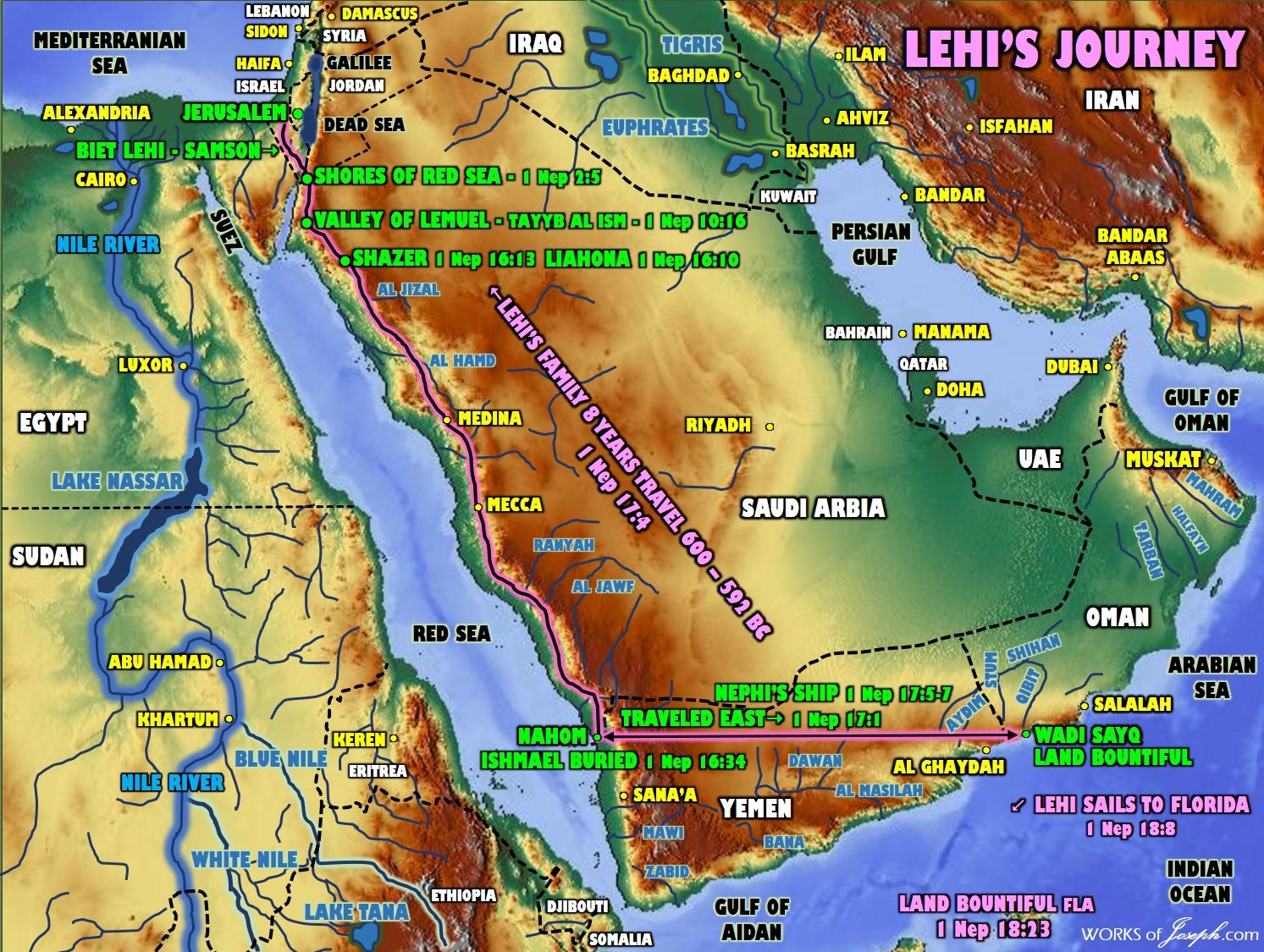
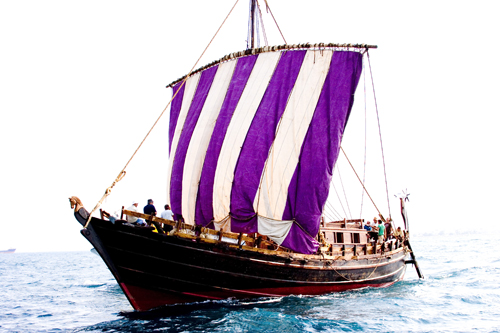
Rod Meldrum about Phoenicia
“The History Channel recently released a documentary called Who Really Discovered America? which explores a number of possible incursions into the Americas by the ancients. In the film they discuss the Book of Mormon account of the voyage of Lehi and his family. Unfortunately, they consulted with Mesoamerican theorists in concluding that Lehi’s voyage would have taken them from the Saudi Arabian peninsula to the western shores of Mesoamerica. This resulted in oceanographic research which showed, using ‘drifters’ (floating buoys that transmit their positions to satellites orbiting earth) that the route would have taken at least 580 days! That is only four months short of two years. They then rightfully conclude that a ship could make such a long voyage, but the occupants could not store enough food and water for such a lengthy trip, and thus the Book of Mormon and Church upon which it is based, is summarily dismissed as being impossible. Watch the clip from the History Channel Thus, because of using Mesoamerican theories, the Church and the Book of Mormon are discredited.
Those who attended the FIRM Foundation’s National Conference in April 2010 were treated to a first-hand account by Keith Johnson of an incredibly important expedition for Book of Mormon enthusiasts. Keith, one of two members of the Church who joined the expedition, sailed for three weeks from the Comoros Islands to Mozambique, gleaning invaluable information relating to Lehi’s voyage in the process. The idea for what is now known as the Phoenicia Ship Expedition, began when several non-Mormon explorers learned of portions of ancient Phoenician ships that had been recovered from the mud of the Mediterranean sea and determined to see if they could confirm the writing of Herodotus in 500 BC who claimed that the Phoenicians (who he also called Israelites) were making circumnavigations of Africa since 600 BC (Lehi’s era).
This astounding voyage has now demonstrated and corroborated the research proposed by Rod Meldrum in 2006 that Lehi’s group may have left the Arabian Peninsula and sailed around Africa to the Americas rather than attempting to cross the earth’s largest ocean at its widest point, as proposed by Mesoamerican theorists. The expedition embarked on this ocean-going journey in a re-created wooden sailing ship patterned after the remains of ancient Phoenician vessels that were plying the oceans around Lehi’s time, near 600 B.C. The expedition has unequivocally demonstrated that a circumnavigation of Africa is not only possible; it is the most likely route for Lehi’s voyage coming from the Old World to the New. The expedition, which left from Oman on the Saudi Arabian peninsula Oct. 26, 2009, reached its final destination less than one year later on Oct. 12, 2010 as it arrived at the Port of Sidon near Beirut, Lebanon in the Mediterranean.
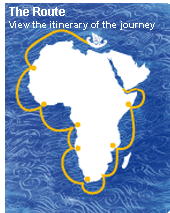
The ship’s captain has been desperately trying to sail north and east toward the Mediterranean from their position just east of Puerto Rico, but the prevailing winds in the Atlantic continued to blow the ship within miles of America! On the journey between South Africa and the straights of Gibraltar the ship came within a few hundred miles from making landfall in North America! They intended to sail north along the western coastline from Cape Town, South Africa toward the Mediterranean, but the prevailing winds in the southern Atlantic blew them in a northwesterly direction, veering thousands of miles away from the African continent and toward the Americas. Once they crossed the equator into the North Atlantic the winds continued to blow them to within a couple hundred miles of Puerto Rico, off the southern tip of Florida in North America! Visit Here to see the entire Video! The assumption that Lehi’s family crossed 10,000 miles of the open waters of the Pacific Ocean to land on the west coast of South America is one that must now be re-examined or discarded. Never before has this level of evidence been available to demonstrate by actual experiment the route most likely to have been taken by Lehi’s family to the Promised Land. Such profound new evidence potentially validating and verifying the Book of Mormon journey has never before been demonstrated and is truly unprecedented in Book of Mormon geography research. You could track this expeditions progress and see photo’s of the ships construction and learn of the ancient sea-faring Phoenician people who left their homes in the Mediterranean Holy Land near Lebanon, Syria and Palestine by ship to circumnavigate Africa in search of trade goods. You can read more about their history by clicking HERE. Such a high level of actual evidence is mostly lacking for routes proposed by Mesoamerican theorists. In fact, the History Channel documentary called Who Really Discovered America actually dismissed the Book of Mormon because of the satellite buoy “drifters” that follow ocean currents, beaming data to scientists who study their movements. Dr. Nikolai Maximenko, Physical Oceanographer with the International Pacific Research Center estimated that an ocean voyage bearing east from Saudi Arabia across the Indian and Pacific oceans “would have taken 580 days…that’s more than a year and a half!” Dr. James Delgado with the Institute of Nautical Archaeology then summarizes the problem; “I don’t think there is a question of ships making it. A vessel can make it with dead people.” With that, the entire premise of the Book of Mormon was dismissed. How disappointing that they were misguided by information from Mesoamerican theorists when, had they used the research from the Heartland Model geography, they would have found ample evidence and now even direct validation, that such a voyage was not only possible, but probable. An article titled Sailing with Nephi, in Meridian Magazine by Mesoamerican theorist Warren Aston, discusses an expedition by another ship patterned after a much later 800 AD vessel with a deeper keel which helps it to better sail against contrary winds. In contrast to the Phoenicia, this ship set sail in February from the Arabian Peninsula in an easterly direction towards their final destination of Singapore, off the southern tip of the Malay Peninsula of Southeast Asia. The ship, deemed the ‘Jewel of Muscat’ after the port city where it was constructed, completed its journey across the Bay of Bengal arriving in Singapore, Southeast Asia, July 3rd, 2010.
During the voyage they experienced contrary winds and currents that slowed their progress significantly from reaching their destination, which was only made possible by the ships ability to ‘tack’ against the winds. This is something the earlier design of the 600 B.C. Phoenicia could not have done effectively, due to its shallow hull design. The Phoenicia literally was “driven forth before the wind toward the promised land” (BoM 1 Nephi 18:8) just as described by Nephi. Aston, a Mesoamerican theory adherent, assumes the route of the Jewel of Muscat for Lehi’s voyage as he states that this ship launched in February of this year, “sailing eastwards across the Indian Ocean toward Singapore in much the same direction that Nephi likely did.” According to Aston, Nephi “headed in a different direction” from the Phoenicia expedition. He provided no indication why he believed this to have been the route, nor any evidence to support it. Contrary to Aston’s assumptions, the Book of Mormon provides some critically important clues about when they embarked on their journey. It was a time of harvest of fruits and honey. “And it came to pass that on the morrow, after we had prepared all things, much fruits and meat from the wilderness, and honey in abundance, and provisions according to that which the Lord had commanded us, we did go down into the ship, with all our loading and our seeds, and whatsoever thing we had brought with us,… “ (BoM 1 Nephi 18:6) The summer rainy season along the coast of the Saudi Arabian peninsula occurs in the spring and summer. Date palms bear their fruit after these rains and are harvested from late June through early October.
Flowering plants bloom, enticing bees to produce honey which is harvested in June and November. Lehi’s family harvested fruits and honey just prior to embarking on their epic journey. To do so would require they leave during late summer to early fall. The prevailing winds along the southern Saudi Arabian peninsula alternate from blowing northeasterly in the spring and summer, to southwesterly in the fall and winter months. Were Lehi to cast off for the land of promise after gathering fruits and honey, the winds would naturally have been blowing from the northeast toward the southwest. A sailing ship would have, of necessity, been blown by the wind south along the coast of Africa, rather than east toward India. The natural Indian Ocean currents move in a counterclockwise rotation southward along the east African coast as well, making it the most logical direction for travel in a sailing ship. This route also allows for periodic stops along the coast of Africa to acquire fresh water, food and a break from the monotony of weeks at sea.
The Phoenicians actually planted crops for future expeditions along this route. While rounding the tip of South Africa, about 115 miles from the Cape of Good Hope the good ship Phoenicia encountered a mighty storm that ripped the main sail in pieces amidst 6-7 meter high massive waves. After repairs were made and the ship resupplied, they left South Africa March 22, 2010 headed north along the west coastline of Africa. It was then that the route took a dramatic turn…to the northwest. The ship was being continually blown northwest, carried by the ocean currents and surface winds that circulate counterclockwise in the southern Atlantic, often making nearly 100 miles a day! They continued north over the equator where they then entered the clockwise rotation of the northern Atlantic which continued to cause the ship to veer further and further west until they found themselves only 300-400 miles off of the coast of Puerto Rico.
Had they not been so determined to fight against the currents and continue north, at the rate they were traveling, they could have made landfall in the America’s in four days. Instead they continued north, making their furthest westerly point on June 12th. By this time they were about the same latitude as Florida and they began to gain the north easterly currents that then swooped them back east toward the Azores in the mid-Atlantic. From the Azores they sailed north in order to catch the south easterly currents that eventually took them south to the straits of Gibraltar and finally across the Mediterranean Sea to their destination.
The longest leg of their journey, from South Africa to their most westerly point near North America took 74 sailing days, less than three months at sea. They did make two stops on this leg at St. Helena Island and Ascension Island, which may have been stops for Lehi’s group as well, since they were being led by the Lord through the Liahona. The ship, about 60-70 feet in length with a crew of between 9 and 18 could accommodate enough fresh water and food for such a journey. There would have been no requirement to cross the mighty Pacific Ocean, the largest on the planet at its widest point against the known currents just so that they could land on the west coast of Central or South America somewhere as speculated by some LDS theorists.
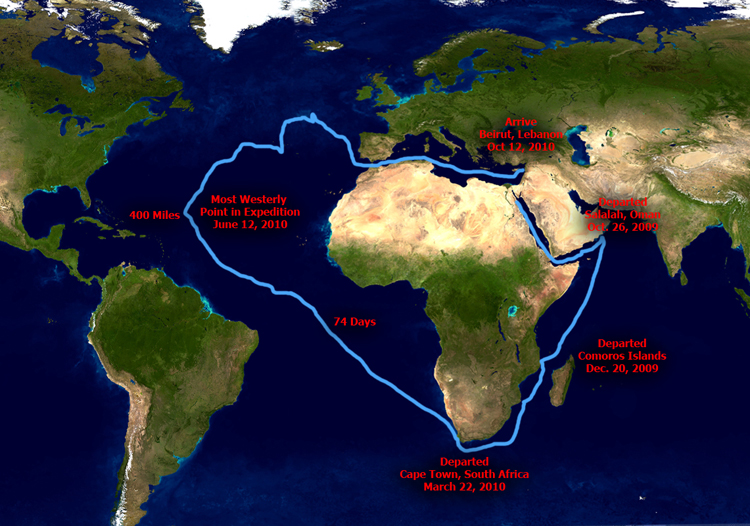 Some have claimed, incorrectly, that there is a scriptural requirement for a west coast landing. However, nowhere in the Book of Mormon does it state that they sailed east in their ship or that they landed on the west coast of the promised land. This assumption is unfortunately based on a false report that Joseph Smith claimed that Lehi “…landed on the continent of South America in Chile, thirty degrees South Latitude” and has been thoroughly refuted by Church scholars (See Robert J. Matthews article on the subject).
Some have claimed, incorrectly, that there is a scriptural requirement for a west coast landing. However, nowhere in the Book of Mormon does it state that they sailed east in their ship or that they landed on the west coast of the promised land. This assumption is unfortunately based on a false report that Joseph Smith claimed that Lehi “…landed on the continent of South America in Chile, thirty degrees South Latitude” and has been thoroughly refuted by Church scholars (See Robert J. Matthews article on the subject).
This account has been shown to have been written in the handwriting of Frederick G. Williams in the margins of the Bernhisel Manuscript. It was a false report that was then promulgated time and again by faulty research, claiming that Joseph was its author. That this claim, thought to be made by Joseph Smith, has been shown through historical documentation to have been falsely attributed, is further evidence for the need of solid historical documentation for all claims regarding the mind of the prophet.” Rodney L. Meldrum See the Phoenician Website here:
Read additional information about the artifacts and archaeology showing why we think Apalachicola, Florida may have been the very place where the Hopewell Culture began and where Lehi actually landed near 589 BC. Blog Article Here

Columbus, Lehi, Mulek, Pilgrims and many others came from the East to the New World.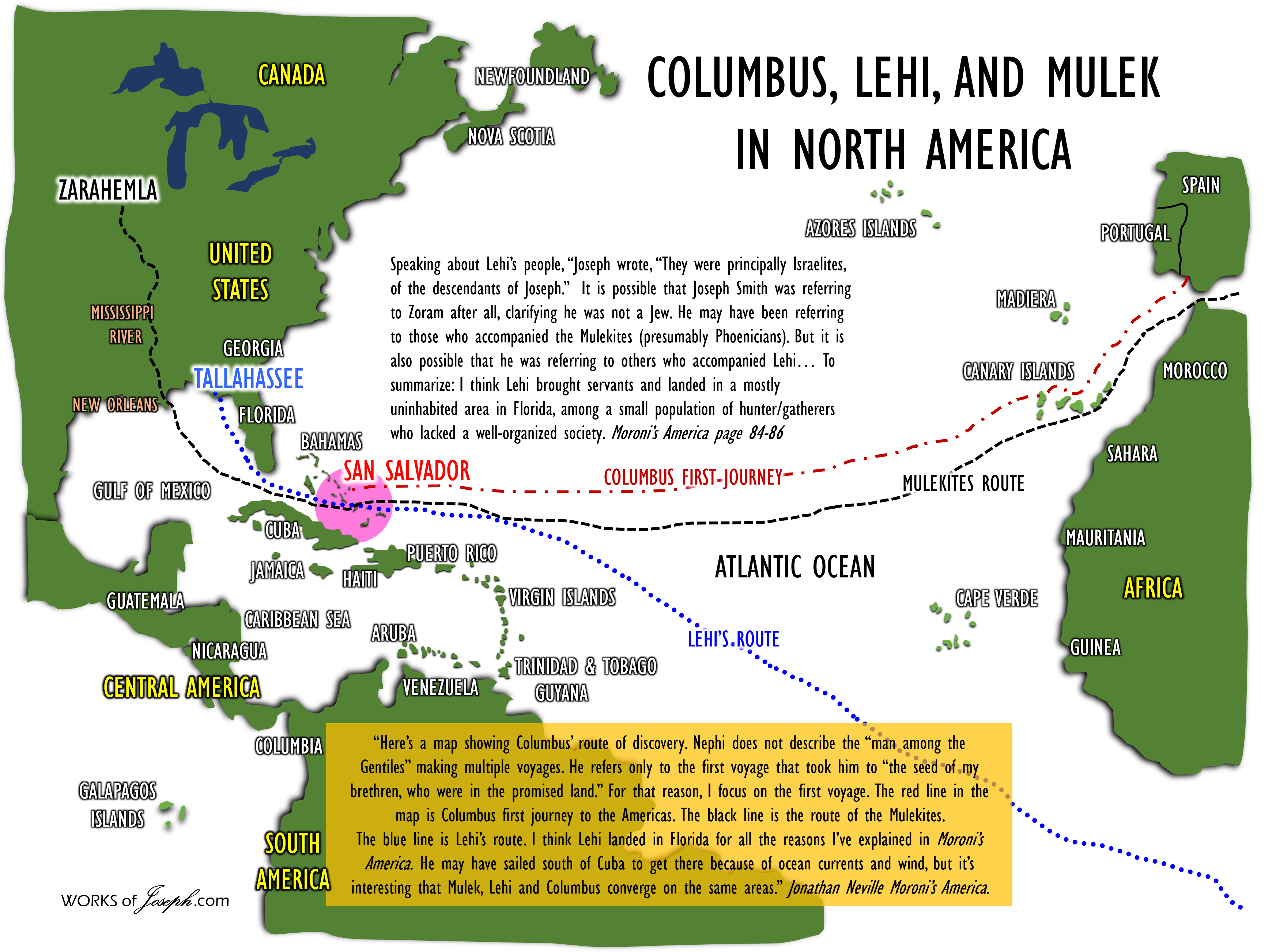
About the 2020, 2nd Voyage to the Promised Land
I just received this press release about the landing of the Phoenicia. The voyage is part of the Phoenicians Before Columbus Expedition, Se my blog about it earlier today HERE!
Replica Phoenician Ship Makes Landfall in Fort Lauderdale, Florida after Unprecedented 6,000-Mile Atlantic Voyage Tuesday, February 4, 2020 at 12:00pm (Time is approximate due to sea and weather conditions)
FORT LAUDERDALE, Fla., Jan. 31, 2020 — Coral Ridge Yacht Club is set to host replica Phoenician ship, Phoenicia for its first U.S. landing after a five-month voyage of over 6,000 miles. The voyage is part of the Phoenicians Before Columbus Expedition, designed with the help of the US-based Phoenician International Research Center, to show that Phoenician ships could have crossed the Atlantic over 2,000 years before Christopher Columbus “discovered” the American continent.
The Phoenicia began its voyage from Carthage, Tunisia on September 28, 2019. After sailing from Carthage to Cadiz, Spain, Essaouira, Morocco and Tenerife in the Canary Islands, the ship left the Old World on November 23, 2019 and safely reached port in the Dominican Republic on December 31, 2019, having crossed the Atlantic Ocean using nothing but wind, current, sail and compass.
The Phoenicia will make landfall on American shores Tuesday, February 4, 2020, docking at Coral Ridge Yacht Club in Fort Lauderdale, Florida (2800 Yacht Club Boulevard). Viewing of the landing is open to the public. To reserve a space, call Coral Ridge Yacht Club at 954-566-7886.
“We are honored to host the Phoenicia and its crew at Coral Ridge Yacht Club, and to be part of this exciting moment in history,” said Commodore Pru Lewis. “We are also excited to welcome the local community to our Club to view this magnificent ship.”
The Phoenicia is a traditionally-built replica of a Phoenician merchant vessel, based on a 600 BC design. British Adventurer and Expedition Leader, Philip Beale FRGS, captains the Phoenicia, sailing with a multi-national crew with representatives from the United States, Lebanon, Tunisia, United Kingdom, Norway, Holland, Brazil and Indonesia. Amongst the crew is filmmaker Yuri Sanada from Aventuras Produções, Brazil. He is documenting life on board as well as the challenges the Phoenicians were likely to have faced.
According to Greek geographer and historian, Strabo, the Phoenicians traded and settled along the East Atlantic coast, prompting Beale’s belief in the likelihood that the Phoenicians would have attempted to sail West in the hope of discovering more lands. Beale commissioned the building of the Phoenicia ship 12 years ago. It was traditionally built in Syria and its design was based on the wreckage of the Jules Vernes 7, discovered in the Mediterranean in the early 1990’s. The Phoenicia is believed to be the only replica of its kind in the world. Having already circumnavigated Africa in the First Phoenician Ship expedition (2008-10), Beale was once again at the helm for the cross Atlantic challenge; reiterating his passion for the seafaring Phoenicians.
The Expedition has been endorsed by the Ministries of Information and Tourism of the Republic of Lebanon and received support, expedition supplies and services from numerous organizations in the Republic of Tunisia, prior to the launch of the Expedition from Carthage, Tunisia in September 2019. The Expedition is part of the United Nations Environment ‘Clean Seas Campaign’, taking daily water samples to measure micro plastic levels and raising awareness about plastic pollution in the ocean. A wide international following has already grown for this unusual and inspired endeavor. Some believe the Phoenicians made it to the Americas and look for genealogy and archaeological evidence there. Beale is focused on highlighting their engineering and maritime skills and hopes that one day his work will contribute to wider archaeological findings to inform a bigger Phoenician story. Phoenicians Before Columbus is approved by the UK’s Scientific Exploration Society and the expedition is the proud recipient of the 2019 Captain Scott Society’s ‘Spirit of Adventure’ Award. The journey across the Atlantic from Tenerife to the Dominican Republic took 39 days, a distance of some 3,700 miles. From the Dominican Republic to Florida, the journey of 1,000 miles will take 12 days. Once completed, the total voyage from Carthage, Tunisia to Florida will have covered over 6,000 miles, taking five months to complete.
For more information or media inquiries, contact:
Roz Alford, Coral Ridge Yacht Club
Cell: 404-580-0387
Email: [email protected]
Related Links: Visit the Expedition Website
Follow the Expedition on Facebook
ABOUT CORAL RIDGE YACHT CLUB For over 70 years, Coral Ridge Yacht Club has beckoned to those who love the water, enjoy an active social life and who desire living life to the fullest. Established in 1947, the Club is located on Florida’s famed Gold Coast along the Intracoastal Waterway and offers an escape into a tropical paradise. Mingling the traditions of old-world elegance with fun, fellowship and relaxation, this charming haven offers the magic of the true South Florida lifestyle, including award-winning cuisine, picturesque landscapes and an abundance of social activities and entertainment.

